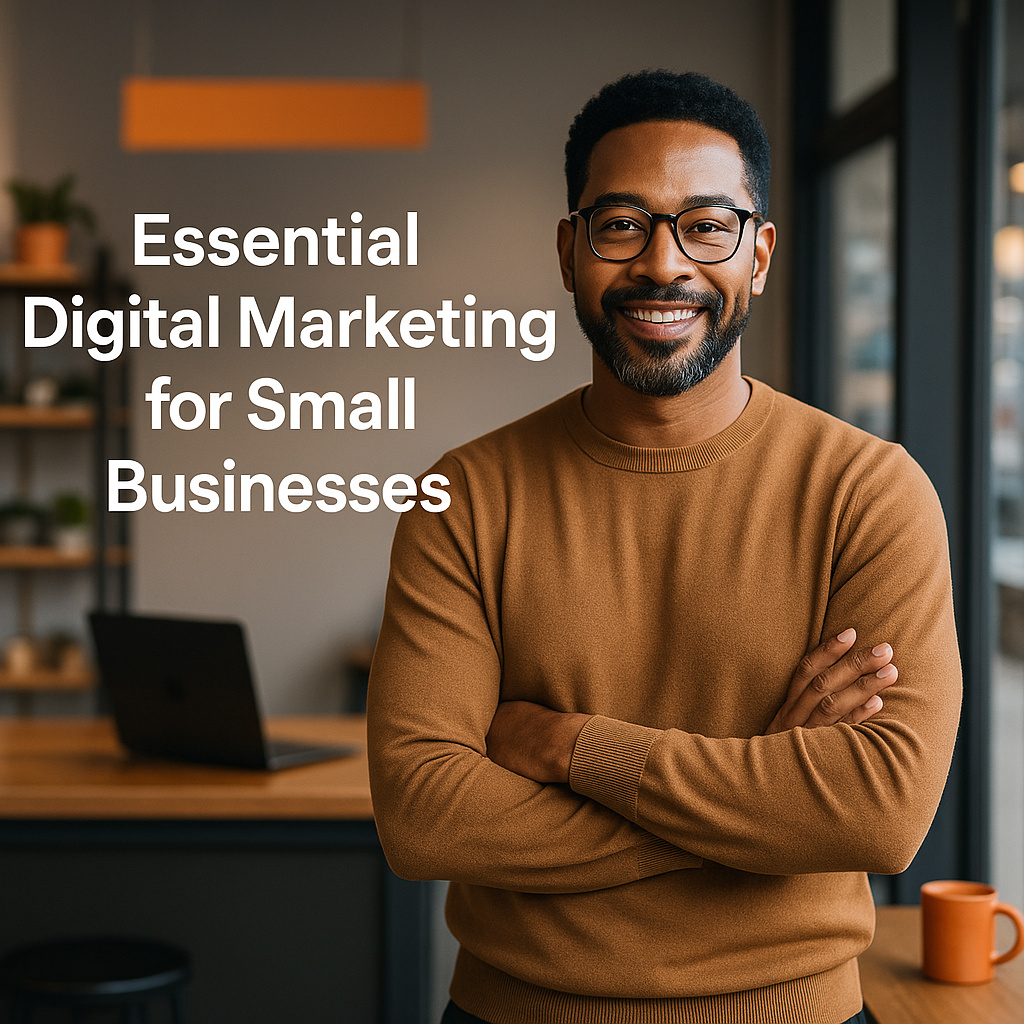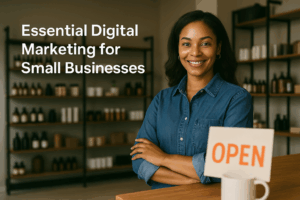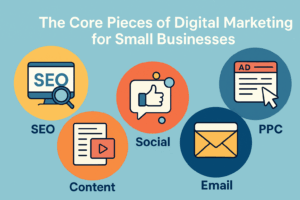What Is Digital Marketing for Small Businesses?
Digital Marketing for Small Businesses works when you keep it simple. This guide shows clear steps, real tools, and a plan you can use this week.
Digital Marketing for Small Businesses covers every way you reach people online—search, content, social, email, and ads. Your goal is easy: get found, earn trust, and drive sales.
Why it matters
- Most customers research online before they buy.
- Email, search, and ads can reach them at the right time.
- You can start small and scale as you grow.
Expert tip: “Pick one main channel per quarter and go deep,” says Titonian Wallace Sr., owner of Nesace Media. “Focus beats busy work.”
Helpful read: See the top guide to digital marketing tools for small businesses for setup ideas.
User Intent: What Small Owners Want
You want more leads, quick wins, and a plan that fits your time and budget.
Common goals
- Book more calls
- Lift online sales
- Lower cost per lead
- Improve reviews and local visibility
Quick wins
- Fix your Google Business Profile
- Speed up your site
- Capture emails with a simple lead magnet
The Core Pieces of Digital Marketing for Small Businesses
Use this stack as your base. Add more when the first pieces work.
Channel fit table (start here)
| Channel | Best for | Time to see wins | Typical cost range* |
|---|---|---|---|
| SEO | Local leads, long-term growth | 3–6 months | Low–Med |
| Content (blog/video) | Trust, rankings, sales enablement | 1–3 months | Low–Med |
| Social | Awareness, community | 0–2 months | Low |
| Nurture, repeat buyers | 0–1 month | Low | |
| PPC (search/social ads) | Fast leads, testing | 0–2 weeks | Med–High |
*Costs vary by niche and market.
Explore when to use SEO vs. PPC with this guide: SEO vs PPC: choose the right strategy for growth.
SEO Basics: Get Found Without Paying
SEO helps people find you when they search. Start with these steps.
- Fix on-page items: clear titles, meta descriptions, headers, and internal links.
- Target local terms: “plumber in Hillsboro” beats “best plumber.”
- Earn trust: add reviews, case studies, and FAQs.
- Build internal links: connect related posts and pages.
Toolbox: Google Search Console, PageSpeed tools, and the best techniques for improving online visibility through SEO.
Why stick with it? Search traffic compounds over time, and ad costs don’t.
Content That Sells (Blog, Video, and More)
Great content answers buyer questions fast. Keep it short, clear, and helpful.
What to publish
- Problem posts: “Why is my AC bill so high?”
- How-tos: “How to measure a ring size at home.”
- Proof: case studies, before/after, testimonials
- Video: demos, unboxings, and quick tips
Pro tip: Repurpose one idea into blog + short video + email + social thread. See: Integrating video marketing into your strategy.
Stat to note: Half of marketers plan to increase content marketing investment in 2024, per HubSpot’s State of Marketing. ([HubSpot][1])
Social Media: Pick, Post, Profit
You don’t need every platform. Pick where buyers hang out and post with a plan.
Platform fit table
| Platform | Best for | Post cadence | Sample content |
|---|---|---|---|
| Local service, community | 3–5x/week | Offers, reviews, FAQs | |
| Visual brands, local | 4–7x/week | Reels, stories, UGC | |
| B2B, hiring | 3–5x/week | Tips, case studies | |
| TikTok | DTC, creative | 5–7x/week | Short demos, behind-the-scenes |
Time-saver: Batch posts once a week and schedule them.
Need help? Compare tools in our mastering social media management guide.
Email: Still the Highest ROI
Email turns clicks into customers. Build a simple “welcome” series and a weekly tip.
- Offer a lead magnet (checklist or coupon).
- Send value first, pitch second.
- Keep one clear CTA.
ROI proof: Many teams see $10–$50 back for every $1 spent on email, per Litmus’ 2025 report. ([Litmus][2])
Level up with personalized email marketing campaigns.
Paid Ads: When to Use PPC vs. SEO
Use PPC to test offers fast or cover high-intent keywords you can’t rank for yet.
- Start with branded and bottom-funnel search terms
- Use exact match + tight locations
- Send traffic to landing pages, not your home page
- Pause what doesn’t convert
Benchmark signal: Google Ads’ average CTR in 2024 was ~6.4% across industries. Your niche may vary. ([WordStream][3])
Analytics That Matter (No Guesswork)
Track a small set of KPIs and review weekly. You don’t need 50 dashboards.
KPI quick table
| Goal | KPI to track | Simple target |
|---|---|---|
| Traffic | Organic sessions | +10–20% per quarter |
| Leads | Form fills / calls | +15% per quarter |
| Cost | Cost per lead (CPL) | Down 10% in 90 days |
| Sales | Conversion rate | 2–5% (site), 15–30% (landing pages) |
| Retention | Email repeat purchase rate | +5% in 90 days |
Use Google Analytics and Search Console for the basics. HubSpot’s data hub has more current stats if you want to benchmark your mix. ([HubSpot][1])
Chart: Sample CPA by Channel
Tip: Compare CPA and lead quality. Cheaper isn’t always better.
For deeper tactics, dig into mastering marketing analytics and our post on unlocking digital marketing analytics.
Build a Simple 90-Day Plan for Digital Marketing for Small Businesses
Week 1–2
- Set goals and baselines
- Install GA4 & Search Console
- Create 2 core offers (lead magnet + entry offer)
Week 3–6
- Publish 4 blog posts + 4 short videos
- Launch 1 landing page + 1 lead form
- Start a 3-email welcome series
Week 7–10
- Turn best post into a short ad test (retargeting)
- Add 10 internal links across posts
- Collect 10 new reviews
Week 11–12
- Prune weak ads and pages
- Ship an FAQ page
- Plan the next quarter
Need a partner? Explore small business digital marketing packages or hire a digital marketing agency for small businesses if time is tight.
Budget Guide for Digital Marketing for Small Businesses
There’s no single number. Use ranges and adjust by results.
- B2B: 2–5% of revenue is a common rule of thumb. ([BDC.ca][4])
- B2C: Often higher due to volume and creative.
- Many marketers are still increasing digital spend as content and ads drive results. ([HubSpot][1], [Shopify][5])
Sample split (starter)
- SEO & Content: 35%
- PPC/Retargeting: 35%
- Email/CRM: 15%
- Tools & Creative: 15%
If you’re price-sensitive, look for affordable digital marketing for small businesses before scaling.
Tools to Run Faster (and Cheaper)
Start with the best digital marketing tools for small businesses you can manage in-house. Then add more as you grow.
- Analytics: GA4, Search Console
- SEO: keyword tools, on-page checkers
- Content: planning board, AI drafting tools
- Social scheduling: pick one app and stick with it
- Email: segmentation + simple automation
Grab our curated list: top guide to digital marketing tools for small businesses.
Proof & Trends You Can Use
- Email keeps winning: strong ROI reported year after year. ([Litmus][2])
- Content spend up: half of marketers plan to invest more. ([HubSpot][1])
- Ads still key for speed: solid average CTR benchmarks guide tests. ([WordStream][3])
When you’re ready to scale, check digital marketing services for small businesses near me and compare small business digital marketing packages to save time.
Key Takeaways
Read this before you launch
- Digital Marketing for Small Businesses works best with one main channel per quarter.
- Keep KPIs tight: traffic, leads, CPA, conversion rate.
- Content + email drive compounding gains; ads add speed.
- Budget by revenue, then shift spend to the winners.
- Use tools you’ll actually use—simple beats fancy.
FAQs
What is Digital Marketing for Small Businesses?
It’s how small teams reach buyers online with search, content, social, email, and ads.
What should I do first?
Set goals, install analytics, and publish a helpful piece this week.
How long until I see results?
Ads can work in days. SEO and content take weeks to months, then compound.
How much should I spend?
Start with a small test. Many B2B firms spend 2–5% of revenue on marketing; adjust by ROI. ([BDC.ca][4])
Do I need every platform?
No. Pick one or two where your buyers are active and show up there.
Conclusion: Your Next Step
Digital Marketing for Small Businesses doesn’t need to be hard. Start with one channel, measure weekly, and scale what works. Want a done-for-you plan? Talk to Nesace Media and we’ll map your next 90 days.
Additional Resources (Nesace)
- Top guide to digital marketing tools for small businesses
- Mastering marketing analytics for business growth
- Integrating video marketing into your strategy
External Sources
- HubSpot: Marketing statistics and trends ([HubSpot][1])
- Litmus: The ROI of Email Marketing ([Litmus][2])




